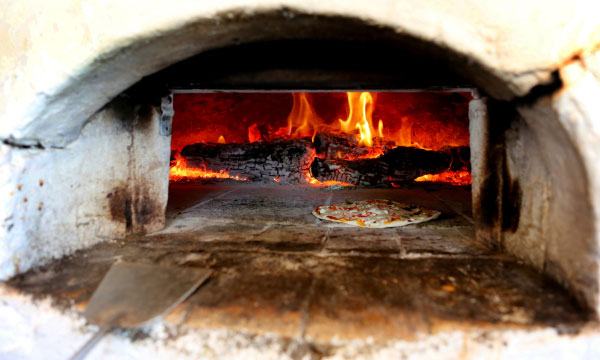Clayman Supplies Limited officially closed for business permanently on 22 August 2025.
Please note we will be fulfilling outstanding orders and admin over the coming weeks.
Handy Hints

How to choose the right materials to build a wood-fired pizza oven
Thanks to the likes of Hugh Fernley-Whittingstall and Jamie Oliver, the popularity of wood-fired pizza ovens has rocketed in recent years – and, despite the array of ovens that are now available to buy, we’re often asked how you can make your own. If you’re interested in building your own oven, we’ve put together some general advice to get you off to the best start and help you choose the right materials for the job.
An age-old concept
The principle of a clay oven is not a new one. In fact, the Romans used something very similar. Back then, they made a structure using flints, lined it with dug clay, and set a fire within the clay structure. When the clay had heated sufficiently, the fire was scraped from the oven, and bread was placed inside to cook as the structure cooled.
So, as you can see, building a pizza oven shouldn’t be an impossible challenge. If you’re thinking about having a go at building one yourself, but you have absolutely no idea where to start, there are plenty of detailed guides online to guide you through the process.
Naturally, though, the first thing people tend to umm-and-aah over are the materials they should use – and, being a ceramic supplier, this is usually the first thing we’re asked about.
So, what materials do I need?
Any guide to building a pizza oven will dictate that you prepare for the build by acquiring a substantial amount of clay and sand (among other things).
Interestingly – and as many of these guides will tell you – it’s almost irrelevant what naturally occurring clay is used, because all clays (at least, all clays we have experience of) will easily withstand the sort of heat that a pizza oven will generate.
But if you’re a complete novice, you might be wondering what we mean by naturally occurring clays. Put simply, when we talk about ‘natural’ clays, we’re talking about those that can be dug from the ground. As you might expect, these clays will vary from location to location.
The most common natural clays are:
- Ball clays – found in Devon and Dorset
- China clays – found in Cornwall
- Fireclays – found above and below seams of coal
- Local clays – typically red earthenwares that will vary enormously, but will always fire to a red terracotta colour
Although any of these clays can be used to build a wood-fired oven, we hear from many people who think that a fireclay will be the best clay for the job, most likely because they assume that it has superior refractory qualities because of its name. This is a misnomer – ball clay could be used with equal, if not greater, success.
Also essential if you’re thinking about building a pizza oven is grog, a generic term given to a granular material made by grinding brick or another fired ceramic. This granular material (which in this case is most likely to be sand, as per the majority of how-to guides) is added to the clay body to add plastic strength and texture, as well as reduce drying and firing shrinkage and introduce a refractory quality to the clay.
Got it! Where can I find the materials?
There are three ways you can source the clay for this project.
The first is by going back to basics and going out digging for it. If this is a practical option for you, there are guides to digging and processing your own clay available online (such as this one, from Ceramic Arts Daily) to give you some pointers.
The second option is by sourcing a clay from a ceramic supplier. Many people go for this option, which is why we’re often probed for advice. If you’re thinking about going down this route, there are a couple of things you should consider.
First of all, don’t forget to think about the plasticity or malleability of the clay body. In simple terms, this is the workability of a clay when mixed with about 20% water, and will make all the difference when you’re working with the clay. As a rough guide, of all the powdered ball clays we sell, Hyplas 71 or HV has the best plasticity; china clays lack the plasticity of ball clays; and local clays have the best plasticity of all clays.
Secondly, you should also consider that any clay you buy over the counter will have been cleaned of its natural impurities (such as flint). As a result, the clay will have a high shrinkage, a property that doesn’t exactly assist in the making of a pizza oven.
For both of these options, you’ll also need plenty of grog to add to the clay for the reasons we mentioned earlier. Builders’ sharp sand is probably the easiest to acquire (you’ll find it in any good builders’ merchants), but we advise limiting the addition to a maximum of 50% to avoid destroying the plastic qualities of your clay. The more sand you add to your clay, the less malleable it will become.
The third and final option is to purchase a premixed clay which has been prepared especially for the construction of pizza and tandoori ovens, such as our Pizza Oven Mix. It’s a very coarsely grogged clay which boasts a very low shrinkage, making it highly resistant to warping, cracking and thermal shock.
What’s next?
Once you’ve sourced the materials, you’re ready to get building! If you’re looking for step-by-step instructions for constructing the oven itself, there’s a plethora of information online: take a look at the River Cottage guide or Delicious magazine’s detailed advice.
If you’re thinking about building your own pizza oven, or you’ve already started and have any questions about using clay, we’d love to hear from you! Get in touch by leaving us a comment below, tweeting us @ClaymanSupplies or posting on our Facebook.
 Facebook
Facebook Twitter
Twitter Pinterest
Pinterest ISSUU
ISSUU






